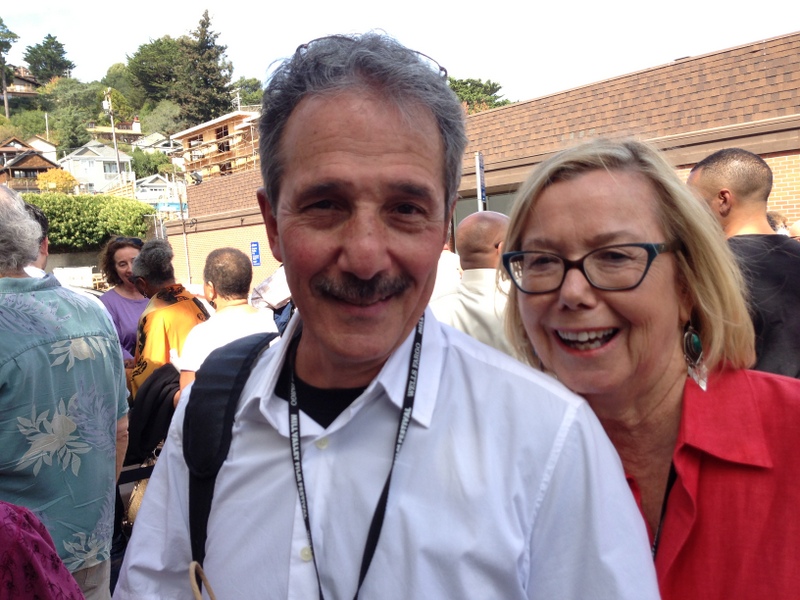
Director Joe De Francesco and associate producer Wendy Drucker (Photo by Rose Pacatte)
Director Joseph De Francesco never forgot the impression that Stephen Vincent Benet’s epic 1928 Pulitzer Prize-winning poem made when he was a student at St. Gregory’s, a high school diocesan minor seminary in Cincinnati. There he found, and admittedly stole, a recording of the 1953 Broadway performed recitation of the poem by Tyrone Power, Judith Anderson, and Raymond Massey. It was adapted and directed by Charles Laughton. De Francesco still has the record.
For his junior year, deciding the path to the priesthood was not for him, De Francesco transferred to what is now Purcell Marian High School in Cincinnati. He was a sports guy who loved drama. The head of the high school’s theater group then was Fr. Clarence Rivers, the first African-American ordained in the archdiocese of Cincinnati. Rivers stayed in contact with De Francesco until Rivers' death in 2004. It was Rivers who encouraged De Francesco when he first expressed interest in dramatizing “John Brown’s Body.” The documentary is dedicated to Rivers.
When Rivers was ill, De Francesco said he would call him to ask how he was. The priest would answer, “Nothing has changed” – a line from “John Brown’s Body” that spoke to the priest’s well-being and also as a social commentary.
De Francesco’s early day job was that of a freelance film editor, but theater was in his soul and he tried over the years to interest theatrical groups in “John Brown’s Body.” “The prison was the last resort to dramatize this,” De Francesco said.
“I had written to Charlton Heston, Meryl Streep, and Denzel Washington, but got no responses," De Francesco said. "I tried everywhere to get a troupe to do it, even little theaters, but no one seemed to care about it. I made cassettes of the record and the people I spoke to seemed bored with it, even though the music alone by Walter Schumann is spectacularly beautiful.”
But rejections and lack of interest didn't stop De Francesco, eventually turning to the prison and prison actors to make this amazing and inspiring 72-minute documentary film. It took three years to showcase and another 12 years to make the documentary.
De Francesco said he is certain that if San Quentin had not had its first female warden, Jeanne Woodford, during this time, the productions would not have happened. “The corrections officers didn't want it to happen. There was concern over use of the “n” word in the poem, that it might incite conflict.”
De Francesco said it was unprecedented that 500 invited guests were able to come into San Quentin, a medium security prison, to be among 5,000 to 6,000 men. All the guests for the two performances had to have background checks and had to go through security points
Both director De Francesco and associate producer Wendy Drucker noted that the film is a “blessed project.” Drucker said that several days after the premiere in the 1990’s, California prisons stopped doing rehabilitation programs. “To imagine the prison ethos is the story of tragedy in America and slavery is the wound of America. But it is harsh and dark in prison, and like slavery, inhuman.”
“Prison tries to take the humanity of the prisoners, and the men, the actors you saw at the premiere, were not the people I met when this project started. Something had come over them, something is revealed in this film. Their humanity emerges and it is wonderful.”
Drucker said she worked quietly behind the scenes, but contends that De Francesco was “unbelievably wise," taking the stories of these prison actors and weaving something together that is incredible. “The proof is in the five men (Larry Miller, J.B. Wells, Jeff Golden, George Lamb, and Ernest Morgan) who were present at the premiere. They found the passion and meaning in themselves to dramatize ‘John Brown’s Body’ and they made it transformational for themselves and for others.”
The film has helped change life in San Quentin as well. Now it has a junior college and a program for arts and rehabilitation – and, Drucker added, the men have proper costumes.
[Sr. Rose Pacatte, a member of the Daughters of St. Paul, is the Director of the Pauline Center for Media Studies in Los Angeles.]




